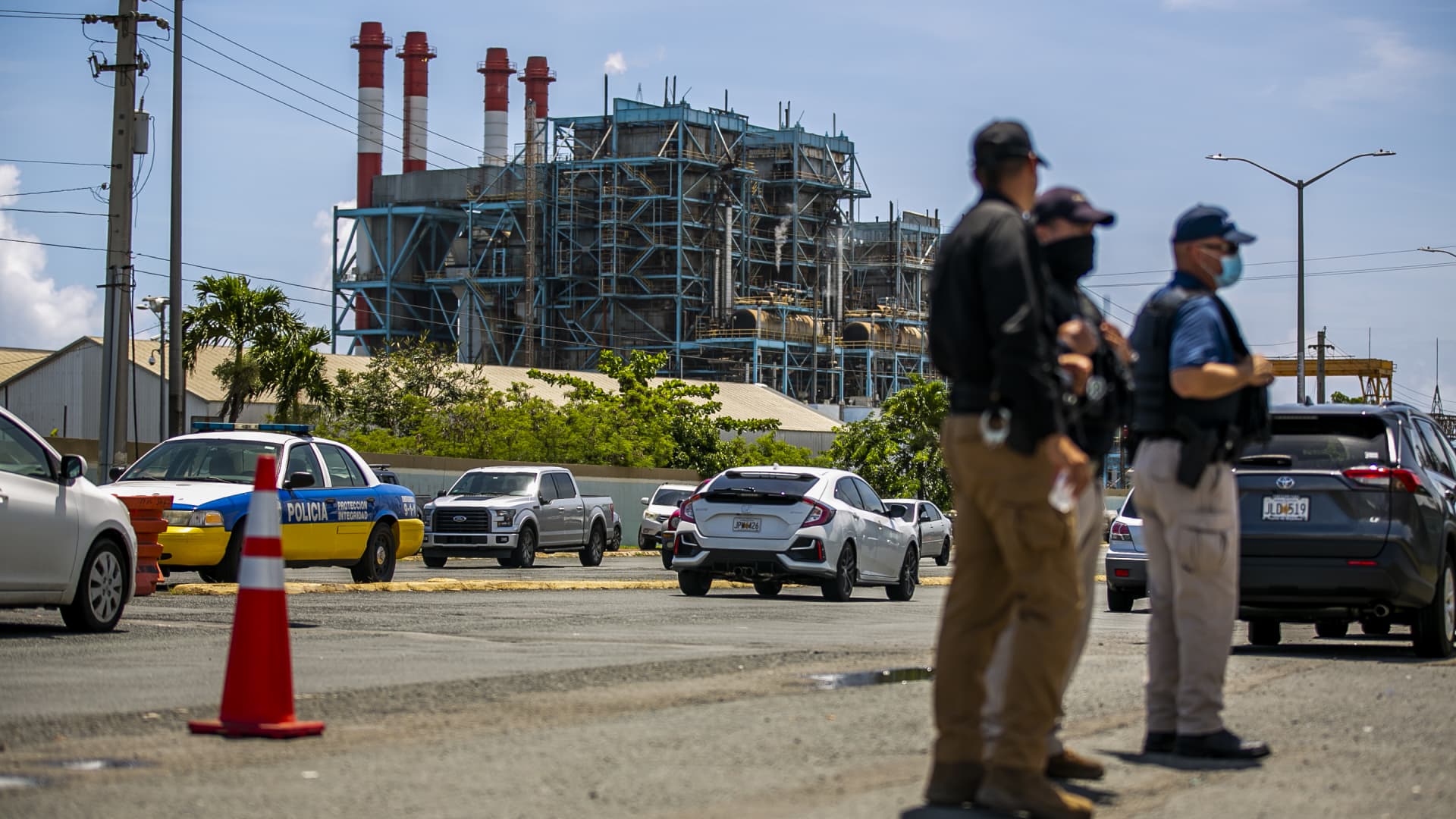Five years after Hurricane Maria, Puerto Rico’s power grid is still costly and unreliable


Police offers stand guard near demonstrators blocking the entrance to a Luma Energy facility at the Puerto Rico Electric Authority (Prepa) Palo Seco Power Plant in Toa Baja, Puerto Rico, on Friday June 4, 2021.
Xavier Garcia | Bloomberg | Getty Images
When Hurricane Fiona hit Puerto Rico in September, Felipe Pérez was ready.
Pérez, the owner of local sandwich shop chain El Meson, equipped his stand-alone locations with power generators and water tanks in the event of a prolonged outage like the one after Hurricane Maria, the devastating storm that ravaged the island in 2017.
His business was one of the lucky ones. Many businesses were forced to shut down for weeks after Hurricane Fiona hit. And even for some businesses that quickly got electricity back, “the cost of operations was so high that they would rather close,” Pérez said.
Lea este artículo en español aquí.
The state of Puerto Rico’s power grid has been a sore spot for many island businesses and residents, leading to backlash against Luma Energy — the company brought in to operate and improve the grid after Hurricane Maria.
Luma Energy officially took over control of the island’s power grid in June 2021 for the Puerto Rico Electric Power Authority, or PREPA. The company, a joint venture between Houston-based Quanta Services and Calgary-based ATCO, was tasked with operating, maintaining and modernizing the island’s beaten-down grid.
It got off to a rocky start.
A report by the Institute for Energy Economics and Financial Analysis found that, in Luma’s first two months of operation on the island, Puerto Rico experienced “longer restoration times, voltage fluctuations and poor customer service.”
Improvements since then appear to have been slow to come, with power outages becoming the norm even before Hurricane Fiona, according to residents and media reports, leading to seemingly growing dissatisfaction with Luma. In September, a Puerto Rico resident told local news station WAPA TV: “Here, you blow out a birthday candle and the power goes out.”
“Since [Hurricane] Maria, they have basically just restrung the wires, they fixed some of the transfer stations, and the basic generation system is still the same,” said Tom Sanzillo, director of financial analysis at the IEEFA. “That means we’re sort of nowhere, and nothing’s really been fundamentally invested in the grid.”
Island residents have also protested due to Luma’s services. In July, about two months before Hurricane Fiona hit Puerto Rico, hundreds of residents marched to Gov. Pedro Pierluisi’s home in Old San Juan, demanding the Luma contract be canceled.
Pierluisi told local newspaper El Nuevo Día that he asked Luma to make some management changes so the company could better handle the situation. Luma didn’t comment on those remarks but has said that the grid — which serves more than 1.4 million clients — had for decades been mismanaged by its predecessor, PREPA, and that “the more than 3,000 men and woman of LUMA are focused on restoring power to every customer impacted by Category 1 Hurricane Fiona and building and transforming the electric system for the future.”
“When we took over about 16 months ago, the situation of the power grid was 60% worse than the worst fourth-quartile utility in the country,” said Shay Bahramirad, senior vice president of engineering asset management and capital programs at Luma Energy.
Bahramirad said that, in those 16 months, the frequency of power outages has fallen by about 30% to 7.6 per year from about 10.6 per client. The company also said Oct. 10 that power had been restored to 99% of clients affected by Hurricane Fiona. After Hurricane Maria, some parts of the island were without power for roughly a year.
But while most of the island may have power restored, customers still need to contend with crippling high energy costs.
Data from the U.S. Energy Information Administration shows that commercial customers in Puerto Rico on average pay 29.4 cents per kilowatt hour as of June 2022. That’s more than double the U.S. average of 12.9 cents per kWh. Residential customers, meanwhile, pay 27.68 cents per kWh on average, while the U.S. average is around 15 cents per kWh.
Luma’s Bahramirad said the company has “nothing to do with increased electricity costs,” adding that this is primarily a function of higher energy costs around the world. Energy prices have soared this year in part due to Russia’s invasion of Ukraine.
But Sanzillo of the IEEFA thinks this disparity could have been at least mitigated through improvements to the grid’s infrastructure.
“If you had changed considerable amounts of the system, you’d still have high prices — you can’t change everything overnight — but you would have been at least buffered a little bit,” Sanzillo said.
El Meson’s Pérez said he hasn’t received the electric bill for September yet but that he would not pay for “electricity that wasn’t consumed.”
All of this comes as Puerto Rico’s economy struggles to recover. FactSet data shows that Puerto Rico’s real GDP has fallen in nine of the past 10 years. On top of that, Puerto Rico’s population fell 11.8% from 2010 to 2020, while the overall U.S. population grew by 7.4% in that time, according to Census Bureau data.
“The exodus has been tremendous, especially among [young adults],” said Pérez. “The island needs young people who can assume leadership roles on the island.”